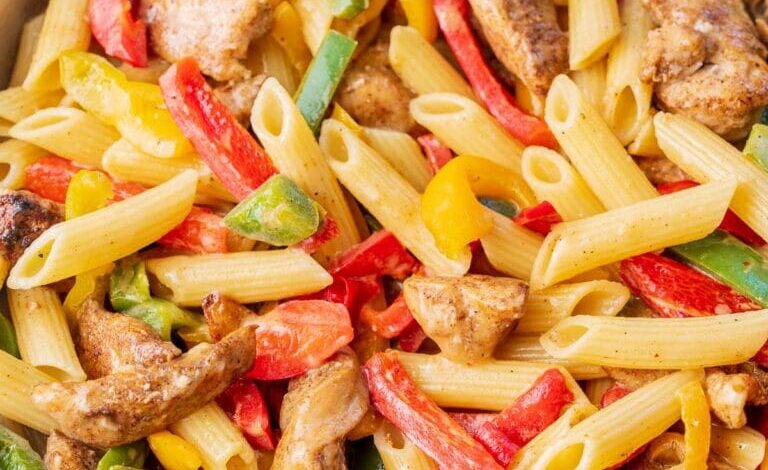
Introduction to Rasta Pasta
Rasta Pasta is a vibrant culinary creation that exemplifies the fusion of Jamaican and Italian flavors, showcasing how diverse culinary traditions can harmoniously coexist. The dish emerges from the rich tapestry of Caribbean cuisine, particularly influenced by the cultural heritage of Jamaica. Its origin can be traced back to the Rastafarian culture, which celebrates freedom, creativity, and unity through various art forms, including food. Rasta Pasta features colorful ingredients such as bell peppers, onions, and, most notably, a medley of spices typical of Jamaican cooking, such as thyme and allspice, combined with traditional Italian pasta. This unique blend results in a delightful meal that resonates with people across different backgrounds.
The name “Rasta Pasta” pays homage to the Rastafarian movement, which profoundly influences Jamaican society. The dish reflects the celebration of life and the appreciation of natural flavors, pivotal aspects of both Italian and Caribbean cooking. As it gained popularity, Rasta Pasta found its way into numerous Caribbean restaurants and beyond, transcending cultural boundaries and appealing to those who seek diverse culinary experiences. It serves as a representation of the melting pot that characterizes Caribbean cuisine, demonstrating how traditional practices can be reinterpreted to create something new and exciting.
This dish is not just a meal; it encapsulates significant cultural meaning. Rasta Pasta symbolizes the infusion of Caribbean spices into Italian cooking, creating a bridge between two worlds. This blending of flavors showcases the creativity inherent in Caribbean cuisine while offering a familiar comfort associated with pasta dishes. As we dive deeper into Rasta Pasta’s components and flavor profile, its significance in contemporary culinary discussions will become evident, illustrating how food can serve as a vehicle for cultural expression and innovation.
The Cultural Significance of Rasta Pasta
Rasta Pasta, a vibrant dish that melds the flavors of Caribbean and Creole cuisine, holds considerable cultural significance, deeply intertwined with Rastafarian beliefs and Jamaican culinary traditions. This unique pasta dish serves as a reflection of the cultural convergence that characterizes Caribbean dining, highlighting the influence of Rastafarian culture on food choices and preparation methods.
The Rastafarian lifestyle emphasizes a profound connection to natural ingredients and a self-sufficient way of life. In Rasta Pasta, we observe this ethos manifesting through the prominent use of fresh vegetables, such as bell peppers, onions, and tomatoes, which are not only colorful but also represent the Rastafarian colors of red, green, and gold. These vegetables are complemented by an array of spices that evoke the warmth and vibrancy of the Caribbean, such as thyme, allspice, and scotch bonnet peppers, which imbue the dish with an unmistakable flavor profile.
Furthermore, the inclusion of pasta in Rasta Pasta speaks to the globalization of Jamaican cuisine, as it represents the fusion of European influences with traditional Caribbean elements. The dish’s adaptability allows it to cater to a wide array of dietary preferences, including vegetarian and vegan diets, further showcasing the Rastafarian principles of harmony with nature and respect for all living beings. The pasta serves as a canvas for the celebration of local produce, which is essential to the dish’s identity.
Ultimately, Rasta Pasta is not just a meal; it is a celebration of the rich tapestry of Jamaican heritage. It serves as a reminder of the resilience and creativity of the Jamaican people, who have adapted and evolved their culinary practices over time. The cultural significance of Rasta Pasta encapsulates the essence of community, spirituality, and nourishment, making it a pivotal dish in Caribbean cuisine.
Key Ingredients that Make Rasta Pasta Unique
Rasta Pasta is a vibrant and lively dish that draws from the rich traditions of Caribbean cuisine. At its core, the dish features a base of pasta, which serves as the perfect canvas for a medley of flavors. The pasta is usually cooked al dente, ensuring it retains a slight bite that contrasts beautifully with the other ingredients. This foundational element can be made using various types of pasta, such as penne or fusilli, catering to different dietary preferences, including gluten-free options.
One of the most striking aspects of Rasta Pasta is the colorful combination of bell peppers, which adds both visual appeal and a spectrum of flavors. Red, yellow, and green bell peppers are commonly used, each contributing its unique sweetness and crunch to the dish. The variety not only enhances the overall taste but also boosts the nutritional value by providing a range of vitamins and antioxidants.
Onions, particularly sautéed yellow or red onions, play a crucial role in developing the aroma and depth of flavor in Rasta Pasta. Their natural sweetness caramelizes during cooking, adding richness that complements the other ingredients. To further elevate the dish, garlic is often included, contributing a potent yet harmonious fragrance that rounds out the flavor profile.
Central to Rasta Pasta’s distinctive character is the use of jerk seasoning, a spice blend that typically includes allspice, Scotch bonnet peppers, thyme, and cinnamon. This seasoning infuses the dish with a bold, smoky, and spicy quality, inviting a taste of the Caribbean. While traditional jerk seasoning is essential, variations can be made to accommodate those who prefer milder flavors by using less spice or opting for a store-bought version that aligns with personal taste.
In addition, protein sources—such as chicken, shrimp, or tofu—can be integrated to enhance the dish and cater to various dietary requirements, making Rasta Pasta a versatile culinary experience that celebrates the essence of Caribbean-Creole cuisine.
Step-by-Step Recipe for Rasta Pasta
Rasta Pasta is a beloved dish that brings the vibrant flavors of Caribbean-Creole cuisine into your kitchen. To embark on this flavorful journey, gather the following ingredients: 12 ounces of pasta (preferably penne or fettuccine), 1 tablespoon of olive oil, 1 onion (sliced), 2 cloves of garlic (minced), 1 red bell pepper (sliced), 1 green bell pepper (sliced), 1 yellow bell pepper (sliced), and 1 cup of coconut milk. Additionally, you will need 2 teaspoons of jerk seasoning, salt, and pepper to taste, along with chopped green onions and parsley for garnish.
Begin by cooking the pasta according to the package instructions. Ensure that it is al dente, as it will continue to cook when combined with the sauce. Once done, drain the pasta and set it aside. In a large skillet over medium heat, add the olive oil. Once heated, introduce the sliced onions and sauté for about 2-3 minutes until they are translucent.
Next, incorporate the minced garlic, cooking for an additional minute until fragrant. Add the sliced bell peppers to the skillet, stirring occasionally for approximately 5 minutes until the vegetables are tender yet maintain some crispness. At this stage, sprinkle in the jerk seasoning, ensuring an even coating over the vegetables.
Pour the coconut milk into the skillet, stirring well to combine it with the seasoned vegetable mixture. Bring this vibrant blend to a gentle simmer, allowing the flavors to meld for about 5 minutes. Season the mixture with salt and pepper according to your preference. Finally, add the drained pasta to the skillet, tossing everything together until the pasta is thoroughly heated and evenly coated with the sauce.
Serve the Rasta Pasta hot, garnished with chopped green onions and fresh parsley. This recipe not only showcases the ease of preparing this delightful dish but also invites you to explore the rich culinary heritage of the Caribbean.
Exploration of Flavor Profiles in Rasta Pasta
Rasta Pasta is a unique culinary creation that exemplifies the vibrant tastes of Caribbean-Creole cuisine. Central to the dish is the robust heat derived from jerk seasoning, which plays a pivotal role in defining its flavor profile. Jerk seasoning is a blend of spices, including allspice, thyme, and scotch bonnet peppers, which not only brings spiciness but also depth and complexity to the dish. The interplay of these flavors results in a tantalizing heat that is balanced by other elements present in the Rasta Pasta.
Another key component of Rasta Pasta is the sweetness imparted by bell peppers. Often, chefs will employ a variety of bell peppers—red, yellow, and green—to add a colorful visual element alongside a sweet, slightly tangy flavor. This sweetness counters the spiciness of the jerk seasoning, resulting in a well-rounded dish that appeals to a broad audience. The vibrant colors of the peppers also enhance the dish aesthetically, making it as appealing to the eyes as it is to the palate.
The creamy base commonly used in Rasta Pasta, often made from coconut milk or cream, adds an indulgent texture to the dish. This richness complements the spices and sweetness, creating a harmonious fusion of flavors. The use of coconut milk not only introduces creaminess but also provides a subtle tropical essence that conveys the spirit of Caribbean cuisine.
Lastly, the incorporation of local herbs and spices, such as parsley, cilantro, and chives, further elevates the overall taste. These fresh elements marry well with the heat and sweetness, contributing to the dish’s aromatic profile. The balance of flavors in Rasta Pasta showcases the creativity of Caribbean-Creole cuisine and offers a delightful culinary adventure for those who indulge in its tastes.
Rasta Pasta Variations and Adaptations
Rasta Pasta, with its vibrant colors and delightful fusion of Caribbean and Creole flavors, offers a versatile base that can be tailored to suit a range of dietary preferences. One appealing approach is to create a vegan version of this beloved dish. Using vegetable-based pasta or gluten-free alternatives like chickpea or lentil pasta can satisfy the demands of plant-based eaters. To keep the essence of Rasta Pasta intact, one can incorporate a medley of sautéed bell peppers, onions, and leafy greens. These vegetables not only provide vibrant colors reminiscent of Rastafarian culture but also contribute to the dish’s overall flavor profile.
For those adhering to gluten-free diets, Rasta Pasta can easily become a delightful option. The use of gluten-free pasta alternatives ensures that individuals with gluten intolerance can savor this dish without concerns. Pairing gluten-free pasta with a rich, creamy coconut sauce, seasoned with jerk spices and fresh herbs, maintains the flavor integrity of the dish while catering to dietary restrictions. Adding protein sources like chickpeas or grilled tempeh can further enhance the nutritional value.
Seafood enthusiasts can also relish in a seafood variation of Rasta Pasta. Utilizing fresh shrimp, scallops, or crab can create a delightful and indulgent twist on this classic recipe. Sautéing these seafood components with garlic, lime juice, and scotch bonnet peppers can add a burst of flavor that complements the pasta perfectly. Furthermore, garnishing with fresh cilantro and a squeeze of lime enhances both presentation and taste, capturing the essence of the Caribbean.
In sum, Rasta Pasta allows for a range of adaptations that appeal to various dietary needs while still heralding its vibrant roots. Whether embracing vegan, gluten-free, or seafood variations, each iteration can retain the dish’s core essence and tantalizing flavors.
Pairing Rasta Pasta with Complementary Dishes
When indulging in Rasta Pasta, a dish infused with vibrant colors and flavors inspired by Caribbean and Creole cuisine, it can be greatly enhanced by carefully selecting complementary side dishes and beverages. The ideal pairings not only complement the pasta but also elevate the overall dining experience.
To start, consider including traditional Caribbean sides that resonate with the flavors of Rasta Pasta. A classic preparation is fried plantains, which provide a sweet contrast to the savory notes of the dish. These golden slices are crispy on the outside and soft on the inside, making them an appealing accompaniment. Additionally, a simple garden salad dressed with a zesty vinaigrette can add freshness, balancing the richness of the pasta.
Another excellent option is the iconic Jamaican rice and peas, which is often made with coconut milk. This dish imparts a creamy texture and nutty flavor, harmonizing beautifully with the spices found in Rasta Pasta. Alternatively, a spicy coleslaw can offer a crunchy texture and a hint of heat that complements the pasta flavors splendidly.
When it comes to beverages, tropical options are recommended to enhance the meal. A refreshing glass of ginger beer or sorrel drink provides a lively counterpoint to the savory notes of the pasta. These beverages not only cleanse the palate but reinforce the Caribbean theme of the meal. For those who prefer alcoholic options, a rum punch or a light, fruity white wine can also pair well with Rasta Pasta, enriching the soirée.
Ultimately, selecting the right side dishes and beverages creates a symphony of flavors that beautifully accentuates the Rasta Pasta, making for a delightful culinary experience. Each accompaniment brings its unique essence, ensuring that every bite is a celebration of Caribbean-Creole cuisine.
Culinary Tips for Perfecting Rasta Pasta
To create a delicious and visually appealing Rasta Pasta, attention to detail in various cooking techniques is crucial. One of the fundamental aspects is cooking the pasta to perfection. Always start by bringing a large pot of salted water to a rolling boil. This not only enhances the flavor of the pasta but also prevents it from becoming sticky. Select a pasta shape that complements your sauce; fettuccine or penne work well for holding onto the vibrant Caribbean flavors. Cook the pasta al dente, which allows it to retain a slight firmness, and remember to reserve a small amount of pasta water before draining. This starchy water can be a handy addition to your sauce, helping to achieve the desired consistency.
Balancing flavors is another vital technique in crafting authentic Rasta Pasta. The traditional dish is characterized by a medley of spices and fresh ingredients. Incorporate fresh garlic, onions, and peppers to create a robust flavor base. Don’t hesitate to experiment with a blend of herbs, such as thyme and parsley, to enhance the dish. Adding coconut milk or a splash of lime juice can bring a creamy, tangy element that highlights the Caribbean essence. Be attentive to the seasoning, as it will elevate the dish, but ensure not to overpower the delicate flavors of your other ingredients.
Additionally, the presentation of Rasta Pasta is key to enticing your diners. Use a colorful assortment of bell peppers—red, yellow, and green—to mirror the vibrant flavors of Caribbean culture. Twirling the pasta creatively on the plate and garnishing with fresh herbs or a lime wedge can make a significant visual impact. Serving the dish in a coconut shell or on a colorful plate can further enhance its appeal. With these culinary tips, you can elevate your Rasta Pasta, resulting in a dish that is not only delightful to taste but also pleasing to the eye.
The Rasta Pasta Experience: Restaurants & Food Trucks
The vibrant flavors and culinary creativity of Rasta Pasta can be experienced in various establishments across the Caribbean and beyond. This dish, which merges traditional Caribbean ingredients with Italian pasta, has gained remarkable popularity in a myriad of dining venues. From fine dining restaurants to casual food trucks, Rasta Pasta is truly making a mark in the culinary scene. One can find this dish prominently featured in many Caribbean-themed restaurants, where chefs infuse local spices with fresh vegetables and succulent proteins.
Notable restaurants such as The Rasta Pasta House in Kingston, Jamaica, have established themselves as must-visit destinations for those eager to savor this unique fusion dish. Renowned for using locally sourced ingredients, they offer several variations of Rasta Pasta, including options with jerk chicken, shrimp, and a hearty vegetarian mix. These establishments not only focus on the taste but also aim to create an inviting ambiance that complements the flavors of the Caribbean.
Food trucks specializing in Rasta Pasta have also become increasingly popular, especially in urban areas and at food festivals. Outfits like Rasta Rollin’ serve up quick, delicious versions of this dish, often accompanied by spicy sauces and fresh herbs. Customers can enjoy their meal on-the-go while experiencing the laid-back, vibrant spirit that the Caribbean is known for. The accessibility of Rasta Pasta through food trucks has broadened its reach, allowing more people to enjoy this culinary innovation.
As Rasta Pasta continues to grow in popularity, it indicates a trend where traditional Caribbean cuisines are merging with global flavors. This delicious fusion dish not only highlights the versatility of Caribbean ingredients but also showcases the evolving landscape of global cuisine. Whether dining in a specialty restaurant or grabbing a quick bite from a food truck, the Rasta Pasta experience is sure to satisfy diverse palates seeking something uniquely flavorful.


